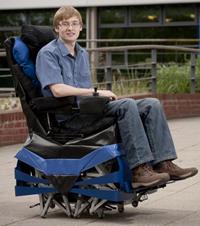|
A student inspired by moving sculptures has designed a prototype 'walking chair' that he hopes could go on to give people with mobility problems greater freedom.  | | Product design student Martin Harris and his 'walking chair'. | Martin Harris, 21 - who is about to complete his BA (Hons) product design degree at the University of Derby developed his battery-powered chair, which uses metal legs instead of wheels, after seeing the 'walking sculptures' of Dutch artist and engineer Theo Jansen. Harris's walking chair will be on display at the University's Markeaton Street site in Derby as part of its annual Degree Shows programme till 11 June. Hundreds of students' work in crafts, fashion, textiles, fine art, film, design, theatre, visual communications, architecture, music technology, creative expressive therapies and art therapy will be on display for the public to come and see for free at the University's Markeaton Street and Britannia Mill sites in Derby, and elsewhere. Harris, originally from Birmingham, said, "I first saw Theo Jansen's work many years ago, he calls the walking sculptures Strandbeests. The walking mechanism had so much potential and I wanted to put it to a practical purpose. "My final year project was to integrate the mechanism into a mobility chair. My uncle works on powered wheelchairs and my dad's a mechanic, so they were able to give me some tips, and my brother assisted me in building and testing the prototype." Instead of wheels the chair moves on a dozen legs, six on each side, which are made up of 216 separate pieces bolted together. The 'one size fits all' seat is completely adjustable, so it will comfortably accommodate anybody. The prototype can move at the maximum wheelchair speed limit of four miles per hour. It is powered by standard wheelchair batteries and motors, which gives it a range of several miles on a single charge. Harris added, "Most motorised wheelchairs are optimised to work indoors or outdoors, not both. The walking chair is compact enough for use indoors whilst also having the all-terrain ability to cross soft surfaces, such as sand or grass, which can prove difficult for wheeled chairs. "This design is a prototype, and I'd be happy to see someone take up the concept and develop it further, for commercial use." Terry Watson, University Programme Leader for the BA (Hons) Product Design course, said, "Our students are expected to think creatively and then use their technical skills to turn ideas into working products. "Martin has shown great ingenuity in taking an art design and seeing how it could be given a very different, practical purpose."
|